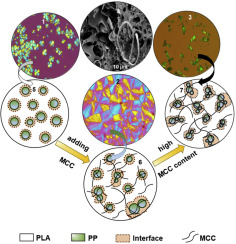Composites Part B: Engineering ( IF 13.1 ) Pub Date : 2019-12-17 , DOI: 10.1016/j.compositesb.2019.107717 Siddharth Mohan Bhasney , Amit Kumar , Vimal Katiyar

|
Modification of mechanical, morphological, thermal and rheological properties of the polymers via melt blending method has been an area of great interest. The present work describes the fabrication of microcrystalline cellulose (MCC) fibre with polylactic acid (PLA) and polypropylene (PP) blend by twin screw extruder to optimize melt processability of the PLA matrix. Compared to PLA, the tensile strength and percentage elongation of PLA80/19.9PP/0.1MCC biocomposites were reduced by ∼32% and ∼4%, respectively. No significant improvement was achieved in the Tg and Tc of the MCC based biocomposites. The PLA spherulite growth rate in PLA80/19.5PP/0.5MCC biocomposite was enhanced to 2.91 μm/min compared to pure PLA matrix (2.53 μm/min). The storage modulus of PLA was increased from low to high frequency while complex viscosity of PLA and its biocomposites showed shear thinning behaviour at a frequency range of 0.1–100 rad/s. Both PLA and PP, showed hydrophobic characteristics. Incorporation of MCC fibres resulted in the decrease in water contact angles of the biocomposites to ∼62°. Thus, it can be concluded that blending of MCC fibres results in considerable changes in the properties of the PLA and PP polymers.
中文翻译:

微晶纤维素,聚乳酸和聚丙烯生物复合材料及其形态,机械,热和流变特性
通过熔融共混方法改变聚合物的机械,形态,热和流变性质一直是引起人们极大兴趣的领域。本工作描述了通过双螺杆挤出机制造具有聚乳酸(PLA)和聚丙烯(PP)共混物的微晶纤维素(MCC)纤维,以优化PLA基质的熔融加工性能。与PLA相比,PLA80 / 19.9PP / 0.1MCC生物复合材料的抗张强度和伸长百分率分别降低了约32%和约4%。T g和T c没有明显改善基于MCC的生物复合材料。与纯PLA基质(2.53μm/ min)相比,PLA80 / 19.5PP / 0.5MCC生物复合物中的PLA球晶生长速率提高到2.91μm/ min。PLA的储能模量从低频增加到高频,而PLA及其生物复合材料的复数粘度在0.1–100 rad / s的频率范围内表现出剪切稀化行为。PLA和PP均显示出疏水特性。掺入MCC纤维导致生物复合物的水接触角降低至约62°。因此,可以得出结论,MCC纤维的共混会导致PLA和PP聚合物的性能发生重大变化。


























 京公网安备 11010802027423号
京公网安备 11010802027423号